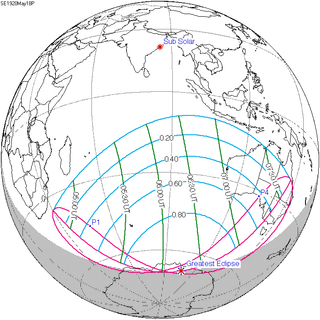| Solar eclipse of May 18, 1920 | |
|---|---|
| Type of eclipse | |
| Nature | Partial |
| Gamma | −1.0239 |
| Magnitude | 0.9734 |
| Maximum eclipse | |
| Coordinates | 69°06′S 107°42′E / 69.1°S 107.7°E |
| Times (UTC) | |
| Greatest eclipse | 6:14:55 |
| References | |
| Saros | 146 (22 of 76) |
| Catalog # (SE5000) | 9328 |
A partial solar eclipse occurred at the Moon's descending node of orbit on Tuesday, May 18, 1920,[1] with a magnitude of 0.9734. A solar eclipse occurs when the Moon passes between Earth and the Sun, thereby totally or partly obscuring the image of the Sun for a viewer on Earth. A partial solar eclipse occurs in the polar regions of the Earth when the center of the Moon's shadow misses the Earth.
A partial eclipse was visible for parts of Australia and Antarctica.
- ^ "May 18, 1920 Partial Solar Eclipse". timeanddate. Retrieved 1 August 2024.
